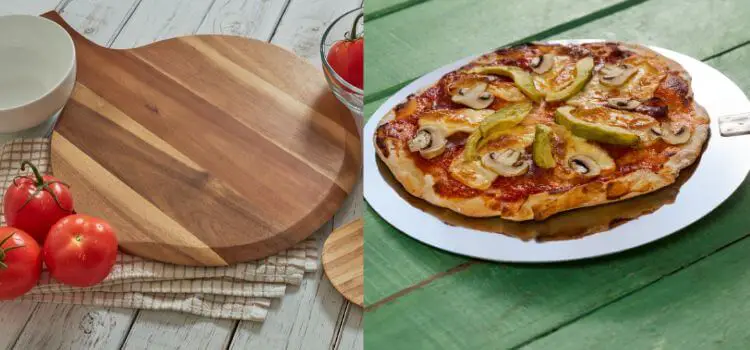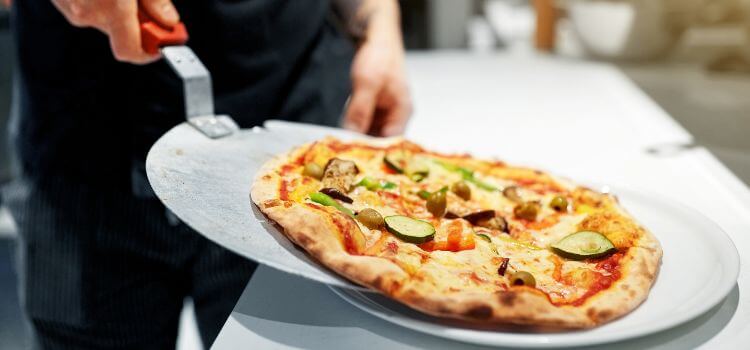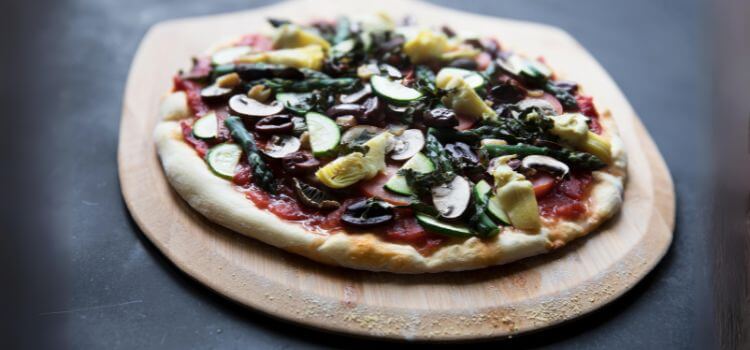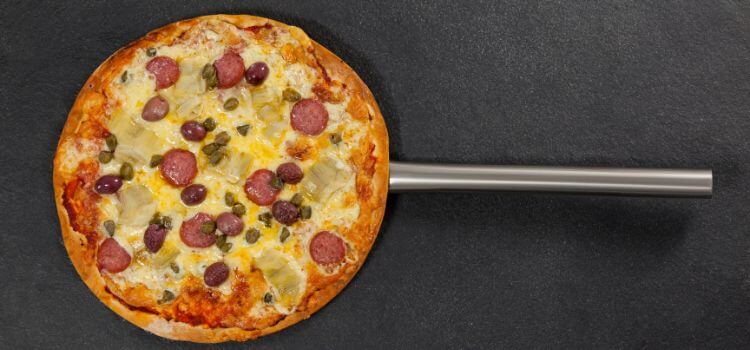As an Amazon Associate, I earn from qualifying purchases

When it comes to equipping your pizzeria with the right tools, the choice between metal and wood pizza peels can significantly impact your kitchen efficiency and overall pizza quality. In this article, we explore the advantages and disadvantages of both metal and wood pizza peels, aiming to guide you towards a well-informed choice that not only improves your operational efficiency but also significantly enhances your pizza-making journey.
Let’s explore the characteristics, benefits, and considerations of each type to guide you towards selecting the ideal pizza peel for your culinary needs.
Characteristics of Metal Pizza Peels

Metal pizza peels are made from aluminium, stainless steel, or cast iron. They typically have a thin, flat surface with a long handle that allows easy maneuvering of pizzas in and out of the oven.
Pros and Cons of using metal pizza peels
Pros:
- Heat Conductivity: Metal pizza peels have high heat conductivity, making them ideal for transferring pizzas quickly and efficiently into hot ovens. This property also helps in achieving a crispy crust and evenly cooked pizza.
- Durability: Metal is a robust material known for its ability to endure high temperatures and withstand repeated use, making metal pizza peels more durable than their wooden counterparts.
- Easy to Clean: The sleek surface of metal pizza peels simplifies cleaning and maintenance, offering you both time savings and convenience in the kitchen.
Cons:
- Stickiness: Due to its smooth surface, the dough may stick to metal pizza peels, making it challenging to slide off the pizza peel and into the oven.
- Heat Retention: The superior heat conductivity of metal implies that the pizza peel will hold onto heat for an extended period, posing a safety risk if mishandled.
Considerations when using metal pizza peels
- Slippery Surface: The smooth surface of metal pizza peels can make it challenging to transfer pizzas, especially if they are topped with heavy ingredients. This can cause the pizza to slide off the peel, leading to a potential mess or injury.
- Not Suitable for Neapolitan-Style Pizzas: Traditional Neapolitan-style pizzas require a slightly moist and floured surface to prevent sticking. With their smooth surface, metal pizza peels may cause the dough to stick and result in a misshapen or torn crust.
Characteristics of Wood Pizza Peels

Wood pizza peels are typically made from hardwoods like maple, cherry, or beech. They have a thicker and more porous surface than metal peels and come with a shorter handle for greater control.
Pros and Cons of using wood pizza peels
Pros:
- Better Handling: The rougher surface of wood pizza peels provides better grip and control when transferring pizzas, reducing the risk of slippage.
- Ideal for Neapolitan-Style Pizzas: Traditional Neapolitan-style pizzas require a slightly moist and floured surface to prevent sticking. Wood pizza peels’ porous surface creates the perfect environment for this type of pizza.
- Aesthetics: Many chefs prefer the look and feel of wood pizza peels, adding a rustic and traditional touch to their kitchen.
Cons:
- Less Durable: Compared to metal pizza peels, wood peels are more susceptible to wear and tear, particularly with regular usage and exposure to high temperatures.
- Difficult to Clean: The porous surface of wood pizza peels makes them prone to absorbing oils and moisture, making it challenging to clean thoroughly.
Considerations when using wood pizza peels
- Not Suitable for High Heat: Wood is a natural material that can warp or burn at high temperatures. Therefore, wood pizza peels may not be suitable for high-heat ovens.
- Regular Maintenance: To guarantee the durability of wood pizza peels, they require regular Maintenance and sealing to prevent warping, cracking, or absorbing unwanted odours.
A Comparison: Metal vs Wood Pizza Peel
Both metal and wood pizza peels have unique characteristics, benefits, and considerations. To help you decide which one is the right fit for your kitchen, here’s a quick comparison:
Metal Pizza Peels:
- Ideal for high-volume production: The smooth surface and heat conductivity of metal pizza peels make them perfect for busy kitchens that require quick and efficient pizza transfers.
- Easy to maintain: Metal pizza peels, known for their low maintenance and durability, are perfectly suited for the demands of commercial use, capable of withstanding frequent operation.
- Not suitable for delicate doughs: The smooth surface of metal pizza peels may not be the best option for transferring delicate or heavily topped pizzas.
Wood Pizza Peels:
- Better handling for delicate doughs: The porous surface and better handling of wood pizza peels make them ideal for transferring delicate or heavily topped pizzas without causing distortion or damage.
- Aesthetically pleasing: Many chefs prefer the look and feel of wood pizza peels, making them a popular choice for presentation in front-of-house settings.
- Regular Maintenance: Wood pizza peels require Maintenance and care to ensure longevity, making them more suitable for smaller-scale production.
Practical Considerations: Metal vs Wood Pizza Peel

Key Considerations for Selecting Between Metal and Wood Pizza Peels:
- Maintenance: Metal pizza peels require minimal Maintenance, making them a practical choice for busy kitchens. On the other hand, wood pizza peels require regular cleaning and sealing to prevent damage and maintain their appearance.
- Durability: Metal pizza peels are more durable and can withstand high heat and frequent use better than wood pizza peels. However, with proper Maintenance, wood pizza peels can also last longer.
- Cost: In general, metal pizza peels are less expensive than wood pizza peels. However, the cost may vary depending on the quality and type of material used.
- Performance in Different Ovens: While metal and wood pizza peels can be used in various types of ovens, it’s essential to consider the specific requirements of your oven. For example, wood pizza peels may not be suitable for high-heat ovens, while metal pizza peels may not be ideal for delicate doughs.
Tips for maximizing efficiency and effectiveness:
- For Metal Pizza Peels: To avoid the dough sticking, gently sprinkle the pizza peel with flour or cornmeal prior to transferring the dough. Moreover, employ a swift flicking motion to effortlessly slide the pizza from the peel into the oven.
- For Wood Pizza Peels: To ensure proper handling and prevent slippage, gently shake or jiggle the peel while transferring the pizza. Also, always use a separate peel for raw and cooked pizzas to prevent cross-contamination.
Conclusion
While both metal and wood pizza peels have their unique characteristics, ultimately, the decision comes down to personal preference and practical considerations. Metal pizza peels offer efficiency and ease of Maintenance, while wood pizza peels provide better handling for delicate doughs and an aesthetically pleasing touch.
By understanding the pros and cons of each type of peel and considering your specific needs, you can choose the best option for your kitchen. We trust that this guide has offered valuable perspectives on the realm of pizza peels, assisting you in making a well-informed choice. Happy pizza making!
As an Amazon Associate, I earn from qualifying purchases
Pingback: Pizza Pan vs Pizza Crisper